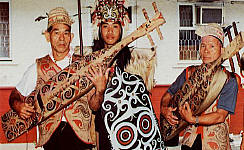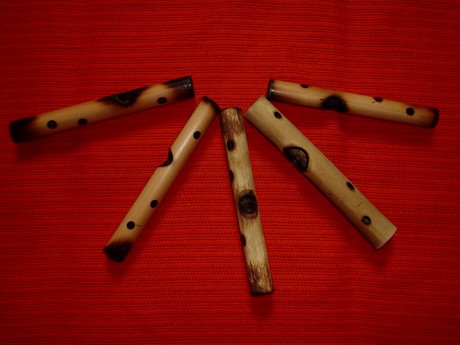Sape / Sapé / Sapeh
sape

The sape (or sapé or sapeh) is one of the largest plucked stringed instruments in the world. It is mainly used on the island of Borneo (which is half Malaysia : Sabah and Sarawak, half Indonesia : Kalimantan; plus the small independent state of Brunei)
The sape is probably made by shipbuilders as the body resembles very much a ship (however the hollowed out bit is on the back...). Maybe that is why this type of instrument is known as "boatlute".
The short neck and square pegbox is also from the same piece of wood. The front is decorated in black and red ink(?) in traditional Borneo tribal patterns.
 |
Some sape have carved decorations. |
The number of metal strings may vary from 3 to 5 and can be tuned with round wooden pegs from both sides of the peghead.
Each string is the same gauge and has its own small bamboo bridge, giving each a different string length. They run over a flat bamboo bridge and go through holes to the back of the instrument. Only the first string has (flat bamboo) frets in a diatonic scale.
Playing the sapeh is quite awkward, as your hand can not really grip the "neck", but more or less have to press on the front of the body. Only the first string is fingered, the others are used as drones (it feels a bit like playing upside-down dulcimer). The sound is not very loud. The repertoire is about 35 different tunes.
 |
The instrument seems still quite popular and some are even made electric. Also combinations like sapetar (guitar) and sapelele (ukulele) are made : see Gimmusic.com . There are not many CD's available. For more information see Sapeborneo |
Komentáře
Přehled komentářů
Please refer to the website you found this item : ATLAS of Plucked Instruments.com ! Thanks


webmaster-atlas
(webmaster-atlas, 13. 5. 2008 22:35)